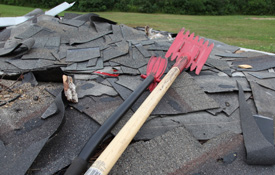 I’ve just re-shingled a roof I originally covered with asphalt shingles 20 years ago, and seeing how the roof aged taught me three things you’ll probably find valuable. The first has to do with how sneaky water can be.
I’ve just re-shingled a roof I originally covered with asphalt shingles 20 years ago, and seeing how the roof aged taught me three things you’ll probably find valuable. The first has to do with how sneaky water can be.
The roof covers an open verandah, and the slope is shallow and similar to what you see on a lot of bungalows. Although I originally capped the edge of the roof with aluminum starter strip to keep the roof boards dry, there were a few places where water didn’t behave itself. Some of the wood showed evidence of water wicking up past the top edge of the 3-inch wide aluminum starter strip as it sat underneath the shingles, wetting the pine roof boards as it did. Staining told the tale, and though there was no rot present, I certainly don’t want this to continue. That’s why I installed a 9-inch wide strip of very thick and sticky ice and water shield made especially for use around eaves, with the main ice and water shield sitting on top of that. The extra-sticky layer bonds to the top edge of the starter strip, extending a waterproof layer up higher than wind-driven rain can travel. You can also buy extra-wide aluminum starter strip that does the same thing.
Stripping old shingles can either be difficult and coarse, or easy and precise. The difference has to do with the stripping tools you use. I used two different kinds of my latest roofing job. The first has a 6-inch wide blade with both front and back edges notched to grab nails and lever them out of the roof sheathing. The second tool is much smaller, with a short handle for single-handed use around flashing and other sensitive areas.
The value of fiberglass shingles is the third thing my roofing job taught me. The shingles I stripped never did reach the 25 year life expectancy they were supposed to have. In fact, these shingles were in worse shape that almost any other old roof I’ve seen. Back when I shingled the roof originally, organic asphalt shingles were the only thing going. The word “organic” in this case has nothing to do with pesticide-free production, but refers to the felt substrate that’s impregnated with tar and gravel. Fiberglass shingles look the same as organics, but the substrate is made of highly heat-resistant glass fibers. This is one reason fiberglass shingles are offered with impressive warranties extending for 40 or 50 years. Some fiberglass shingles are even warranted for the life of the home. Time will tell if these optimistic numbers play out, but from what I’ve seen since fiberglass shingles commonly began appearing on roofs 15 years ago, I expect they will.